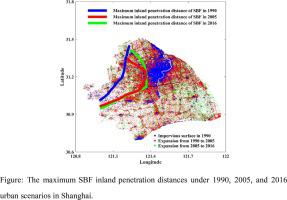Landscape and Urban Planning ( IF 7.9 ) Pub Date : 2021-11-11 , DOI: 10.1016/j.landurbplan.2021.104287 Wei Wang 1 , Jiong Shu 2, 3

|
Assessing the impacts of urbanization on the inland penetration of sea breeze fronts (SBFs) is an urgent requirement if we are to mainstream nature-based solutions in urban planning of coastal cities. SBFs are vital for the natural ventilation in urban areas. However, the interactions between SBFs and urbanization remain unclear in a mega-river delta, which often undergoes spatiotemporally uneven urban development. This study uses sensitivity experiments to examine the 1990, 2005, and 2016 SBF scenarios from Shanghai, China. We utilized a weather research and forecasting model to evaluate the SBF response to urbanization that incorporated both temporal variability; i.e., different rates of urban expansion and renewal, and spatial variability; i.e., uneven urban growth at various distances from the coastline. Furthermore, the contribution of thermal and aerodynamic factors to the SBF inland penetration was quantitatively separated using multiple regression models, into which dummy variables that measure urbanization-related roughness factors were introduced. The results show that maximum SBF inland penetration distances followed a temporally uneven reduction pattern, with rapid rates of reduction between 1990 and 2005 (4.1–6.3 km/10 yr), and slow rates of reduction between 2005 and 2016 (0.3–2.1 km/10 yr). These distances were also spatially uneven, with SBFs in southeast Shanghai being >10 km deeper than those in the northeast. In addition, the SBF inland penetration models indicate that surface roughness with negative effects, as well as urban heat island and normalized wind direction with positive effects are the three most important controls on penetration distance. These findings suggest that urban planners should therefore account for controlling coastal development, urban renewal measures, and urban ventilation, which could be important contributors to maximizing the role of SBFs in improving the urban environment in a natural way.











































 京公网安备 11010802027423号
京公网安备 11010802027423号